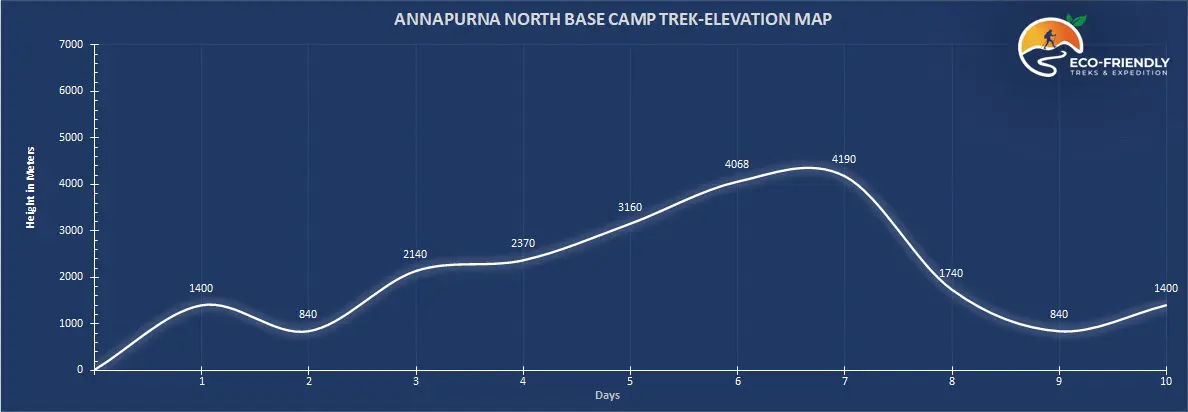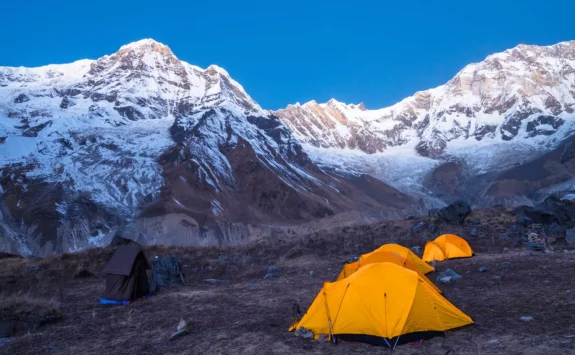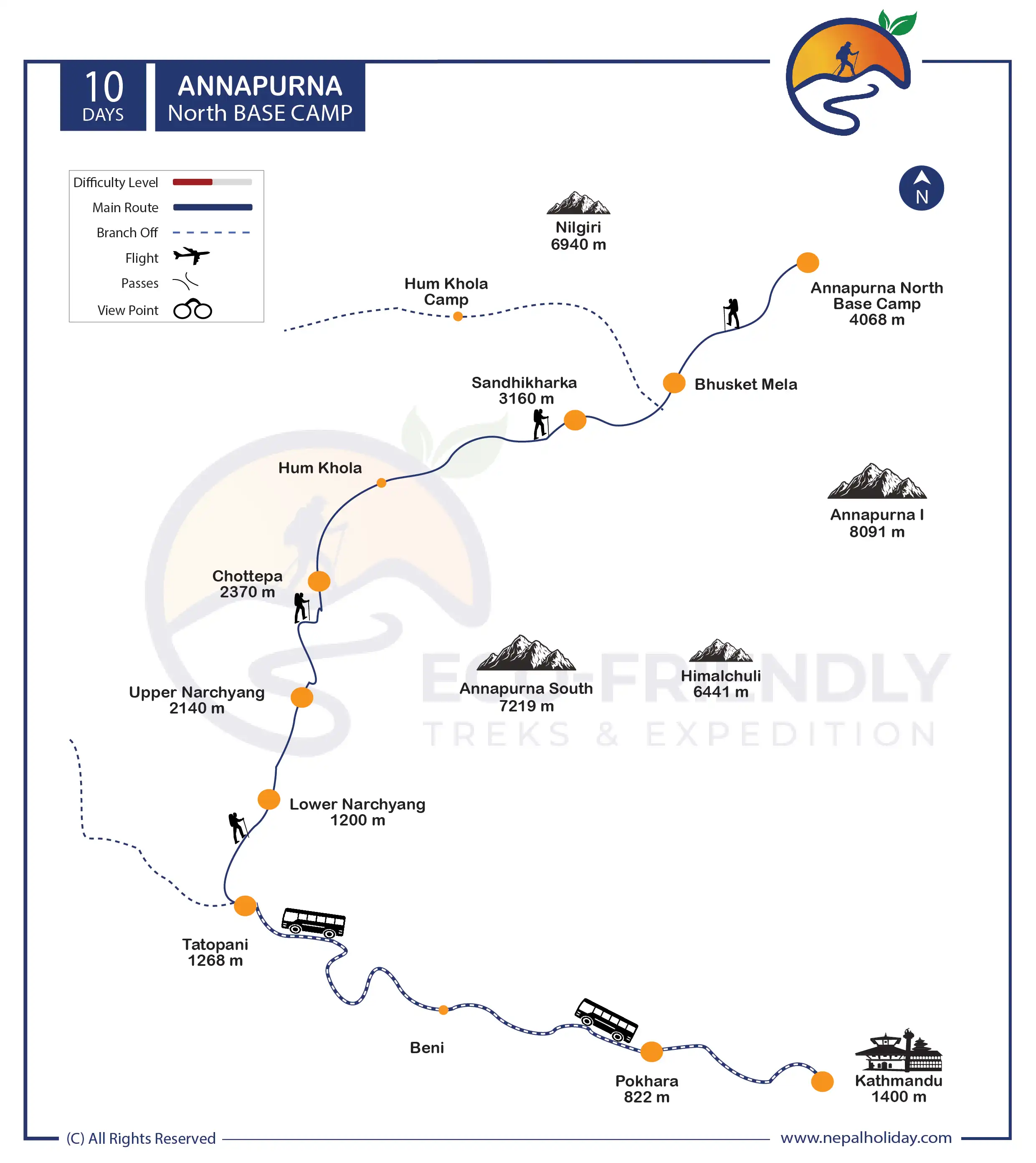Trip Introduction
Overview of Annapurna North Base Camp Trek
People often talk about the Maurice Herzog Trail when they talk about the Annapurna North Base Camp. On June 3, 1950, he made history by becoming the first person to reach the summit of Mt. Annapurna through the Annapurna North Base Camp Trek route. This trail is less used by tourists than the main Annapurna Base Camp road.
If you are looking for something different to do in the Annapurna area, this trek is a great way to have a unique and very exciting journey. The Annapurna North Base Camp Trek is full of wild places and exciting things to do. If you like adventure and hiking in the wilderness, you should choose this trip.
Away from the crowds, trekkers may experience the peace and natural beauty of the Himalayas on the Annapurna North Base Camp Trek. Annapurna 1, Nilgiri, Fishtail (Machhapuchhre), Hiunchuli, Annapurna South, Dhaulagiri, Tilicho, Pisang, and many more are just some of the towering snow-capped peaks that trekkers can meet here.
Is the Annapurna North Base Camp Trek difficult?
Yes, the Annapurna North Base Camp Trek is considered a difficult-level trek. During the trek, you will cross remote and high-altitude terrain. You need to be at a good level of physical fitness and endurance for the trek.
The trek reaches an altitude above 4000 meters, with the Annapurna North Base Camp situated at 4190 meters above sea level. The effects of high altitude can vary among trekkers, necessitating proper acclimatization to prevent altitude sickness.
The Annapurna North Base Camp Trek typically spans a duration of 9 to 11 days, depending on the chosen itinerary. Extended periods of trekking can be physically strenuous, particularly due to the diverse terrain and varying altitudes.
The route passes through remote regions where access to basic facilities and amenities is limited. Accommodation mainly consists of camping arrangements, offering simple meals. The absence of modern conveniences further contributes to the inherent challenges of the trek.

Annapurna North Base Camp Trek Permit
ACAP and TIMS licenses are needed for the Annapurna North Base Camp Trek. After paperwork and royalties, we will issue and purchase permits. However, if visitors have a limited schedule, you can supply us with all the paperwork before your arrival so we can issue the permits.
The ACAP encompasses the whole Annapurna Conservation Area and allows one entry and exit. You can use it for as many treks as you like inside Annapurna until you leave, as it’s only good for entry and departure. The TIMS must also pass the registration checks. These licenses are required.
Itinerary of Annapurna North Base Camp Trek
Today, our day is filled with scenic rides passing through the green hills, forests, and small settlements. We will get the tourist bus from Kathmandu to reach Pokhara. During the drive, the bus will stop on the way for a rest and lunch break, and it takes around 6 to 8 hours to reach Pokhara.
Today, we will have another ride full of adventure, which takes around 7 hours to reach Tatopani. During the ride, we will pass through beautiful rhododendron forests, mountains, and small settlements. After reaching there, we will do a short hike of 2 hours to reach Narchyang.
After eating breakfast, we get an early start on the day’s hike to Chhotepa. The trip will take you through plenty of agricultural fields, grasslands, and Lekhagaun, in addition to rivers such as Ghalemch and Mristi Khola. We expect to arrive at our destination after roughly seven hours of trekking, where we will set up camp.
The trek up to Sandhikharka, which will be our target for the day and will start from Chhotepa, will take around 6-7 hours. Our journey continues as we make our way through the local streams and bamboo forests. When we emerge from the bamboo forest, we get our first glimpse of the NACP mountains, which is the finest treat of the day. Camping for the night at Sandhikharka.
From Sandhikharka to Annapurna Base Camp, it is likely to be a very difficult and lengthy hike. We reached North ABC after a journey of around 7-8 hours on foot through Bhusket Mela.
On the seventh day of our hike, we will spend the day exploring the extraordinary natural beauty of this location. We will get a clear view of the glacial lake and the big glacier that is in our way. After that, we will make our way back to Sandhi Kharka on the same day and set up camp there.
In Chhotepa, on our way back to Lower Narchyang, we will hike back through the valley where the Humkhola River is. To go to Chhotepa, it will take around 6-7 hours of travel time. To get to Lower Narchyang from Chhotepa, we first take a one-and-a-half-hour journey down an unpaved route. We have a homestay for the night here at this location.
On the final day of the North ABC trip, we begin the day by hiking back to Tatopani. After lunch in Tatopani, we board a vehicle for the trip back to Pokhara.
Includes/Excludes
What's Included?
- A guide to managing the entire holiday.
- Basic yet comfortable accommodation on a twin-sharing basis during the trekking as per itinerary.
- Breakfast, lunch, and dinner are served from the locals’ kitchens during the trek, as per the itinerary.
- Purified drinking water was used during the entire trek as per the itinerary.
- Annapurna Conservation Area trekking permit.
- Kathmandu – Pokhara – Kathmandu by bus transportation.
- Pokhara-Tatopani-Pokhara by sharing Jeep
- General first aid medicine kit.
- One porter for two of you for trekking (prepare to give a max. 15 kg of luggage from each of you so that it will not exceed 30 kg. for your porter).
- Complimentary T-shirt
- Duffle bag during the trip.
What's Excluded?
- Food and Accommodation in Kathmandu & Pokhara
- Any Travel Insurance.
- Do you have any tips for drivers, porters, guides, hotel staff, etc.?
- Any personal expenses and bottled or canned drinks.
- Any additional cost due to natural calamities and unforeseen circumstances.
- All, except “cost includes” above.
Essential Information - Annapurna North Base Camp Trek
Annapurna North Base Camp Trek Preparation
For trekking to North Annapurna Base Camp, you need to be in good shape. With this kind of fitness, you can walk on the rough North Annapurna Himalayan paths along the sides of rivers and even jump and ford rivers to get across. As the air goes up, the path may get rougher, making exercise even more important.
In the same way that being around you is important, so is being fit. At least a month before this trip, walking, jogging, and running every day may be good ways to get in shape. If you are generally fit, you should walk or jog quickly for 5 km/3 miles every day.
You have to have a certain amount of understanding to be interested in Annapurna. In truth, you also need to be mentally fit to be here. For this, it might help to just breathe and be aware of it.
Selecting the Right Season for Annapurna North Base Camp Trek
People often talk about how cold and bad the weather is in the upper Annapurna area. There are times each year when the weather stays the same, making it an ideal season for nature lovers.
Temperatures range from 14 to -8 degrees Celsius in the spring months of March, April, and May. At Annapurna Base Camp, from June to August, the temperature swings from 19 to 4 degrees Celsius. The next season is autumn (September, October, and November), which is also a busy time. In this season, the temperature swings from 20 degrees Celsius to -10 degrees Celsius. Lastly, the temperatures change a lot during the winter, going from 9.3 degrees Celsius to -20 degrees Celsius.
If you want the best views and weather, the best times to walk at Annapurna Base Camp are in the spring and autumn. During these times, tens of thousands of hikers go to Nepal. During these times of the year, the sky will be clear and the weather will be good for hiking.
Annapurna North Base Camp Trek Accommodation
When people go trekking in Nepal, they often stay in tea houses, but on the North ABC trek, you will also have to stay in a tent. At the lower part of the trek, the tea house can be a lodge or a big family home.
Before you go on the adventure trip to North ABC, you should know what you’ll have to do to find a place to sleep. The North Annapurna Base Camp Trail has a limited number of places to stay that provide basic services.
During the busy seasons (March to June and September to mid-December), it can be hard to find teahouses in the lower part of the trek. So, it’s important to book a trip ahead of time so that you can get a place to stay as soon as possible so that the trek goes smoothly and looks great.
Annapurna North Base Camp Trek Foods
In contrast to popular hiking paths, this path has a much smaller selection of tea houses and foods than those trails. Before arriving at base camp, the number of tents in which one may dine or stay significantly decreases, providing basic facilities. As a result, we are going to need to have a suitable amount of food and drink with us on the trek.
The majority of the areas in Nepal that are fortunate enough to have access to food produce local, organic Nepalese cuisine that is intended to provide a nutritionally sound diet.
Altitude Sickness and Acclimatization in Annapurna North Base Camp Trek
Because of the significant elevation rise involved in the Annapurna North Base Camp Trek, altitude sickness is a usual concern. The trek takes you through a variety of terrains, resulting in elevations going over 4,000 meters.
Headaches, dizziness, nausea, and fatigue are common symptoms of altitude sickness. To reduce these hazards, appropriate acclimation becomes essential. Trekkers should ascend gently, giving their bodies enough time to adjust to the decreasing oxygen levels.
Taking proper rest days, staying hydrated, and avoiding excessive effort are all important factors to consider.
Best alternative trekking packages of Annapurna North Base Camp
If you want to extend your Annapurna Trekking vacation, we offer additional Annapurna alternative trip packages. We all have different options when traveling, so we are prepared to develop an alternate package to suit your preferences.
Some may want to stay in the Himalayas for a more extended period with more challenges, so for them, we have the Annapurna Circuit Trek. If you want a very short and easy trek in the Annapurna region without visiting base camp, we have Ghorepani Poon Hill Trekking and Mardi Himal Trekking for you.
We also have some luxury lodge trips to Annapurna Base Camp for you, in case you want more facilities in a remote mountain. You will also have a choice of doing a helicopter tour to Annapurna Base Camp or the Upper Mustang Jeep Tour.
Most asked questions
FAQs about Annapurna North Base Camp Trek
The highest place for this trek is Annapurna North Base Camp with an altitude of 4068m.
Even for seasoned trekkers, being in the Himalayas is a physically demanding exercise, and altitude-related dangers can be a concern. Beginners should begin this journey with more physical and mental preparation. It is also important to contact an expert in medicine to assess your fitness and eligibility for high-altitude trekking.
Annapurna Conservation Area Pemit and TIMs card is compulsory during a trek to Annapurna North Base Camp.
The itinerary we offer for customisation is one of the region’s compact itineraries that we have prepared, taking into account health and other variables. A shorter period to acclimate to a change in climate, humidity, or pH may result in high altitude sickness and other problems.
Aside from that, if you wish to spend more time in the Himalayas, we have fantastic options for extending the days and customizing your program to match your demands. Please contact us; we will put together your ideal package with the help of you and our staff.
It will recommend you to take a guide for this trek if you are an independent trekker, because the trek is newly intouduced. Taking guide will also help your trek to be hassle-free. We highly suggest you go along with a trekking agency to hire a guide, especially if you are travelling to high elevations for the very first time.
Medical tests can help you to know your overall fitness level and discover any existing medical conditions that could represent a risk during the walk. It also helps guides and trek planners in making accurate decisions about your safety and acclimatization timetable.
We would love to have you come to ABC with your children and family since we believe that nature benefits children in a variety of ways. With a trained guide, the journey can be completed with fun and joy.
Get your kids in condition for this walk by having them practice simple exercises and breathing methods for at least a month. Please let us know if you require a kid carry service during the inquiry process.
We already make payments on numerous charges, such as permits, taxes, and others, before embarking on the excursion. Please be aware that this remains the case because we must properly compensate our guides and porters for the time they have committed, even if you do not complete the entire trek. We find it extremely difficult to give refunds for any reason.
We already make payments on numerous charges, such as permits, taxes, and others, before embarking on the excursion. Please be aware that this remains the case because we must properly compensate our guides and porters for the time they have committed, even if you do not complete the entire trek. We find it extremely difficult to give refunds for any reason.
We strongly suggest you start being active 1 month before your holiday to emotionally and physically prepare yourself. In addition, the Soldhunga Hike is available as part of our quick acclimatization training trip. This climb can be used as a preview of what to expect on your major journey in the central Himalayas.
We request you ask our ground team in Kathmandu for assistance in arranging day tours around the city. If you still have time extra few days or a week after the trek, we can also put one of the following quick relaxation trips. Feel free to pick the one you think will best suit your interests.
- Lumbini
- Chitwan Safari
All of these additional vacation days were planned with the idea that you would want to relax after a challenging and long trek rather than go hiking again. Please let us know if you would like any other destinations over these.
Reviews on Annapurna North Base Camp Trek
Be first to post a review in this trip.
© Copyright 2024 Eco-friendly Treks. Website Developed by: AVIVA




